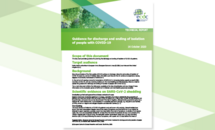#15,506
The ECDC has published a new technical report on when - and for how long - people with COVID-19 are likely to be infectious.
Even though we are 10 months into our COVID experience, this is an area that still has some degree of uncertainty, and so standards adopted for the discharge of patients or cessation of isolation vary around the world.
The CDC's assessment of Sept 10th states:
Available data indicate that persons with mild to moderate COVID-19 remain infectious no longer than 10 days after symptom onset. Persons with more severe to critical illness or severe immunocompromise likely remain infectious no longer than 20 days after symptom onset. Recovered persons can continue to shed detectable SARS-CoV-2 RNA in upper respiratory specimens for up to 3 months after illness onset, albeit at concentrations considerably lower than during illness, in ranges where replication-competent virus has not been reliably recovered and infectiousness is unlikely. The etiology of this persistently detectable SARS-CoV-2 RNA has yet to be determined.
Studies have not found evidence that clinically recovered persons with persistence of viral RNA have transmitted SARS-CoV-2 to others. These findings strengthen the justification for relying on a symptom based, rather than test-based strategy for ending isolation of these patients, so that persons who are by current evidence no longer infectious are not kept unnecessarily isolated and excluded from work or other responsibilities.
Leading to this general recommendation:
Duration of isolation and precautions
- For most persons with COVID-19 illness, isolation and precautions can generally be discontinued 10 days after symptom onset1 and resolution of fever for at least 24 hours, without the use of fever-reducing medications, and with improvement of other symptoms.
- A limited number of persons with severe illness may produce replication-competent virus beyond 10 days that may warrant extending duration of isolation and precautions for up to 20 days after symptom onset; consider consultation with infection control experts.
- For persons who never develop symptoms, isolation and other precautions can be discontinued 10 days after the date of their first positive RT-PCR test for SARS-CoV-2 RNA.
While not varying greatly from the CDC guidance above, the new ECDC recommendations adopt a more conservative 72 hours (vs. 24) resolution of fever as a benchmark for no longer being infectious. This technical report also addresses presymptomatic and asymptomatic infectivity.
You'll want to follow the link to read the (7-page) PDF report in full, as I've only posted a few excerpts.
Guidance for discharge and ending of isolation of people with COVID-19
Technical report
16 Oct 2020
This document provides guidance for planning the discharge and ending of isolation of COVID-19 patients.
Executive summary
Since the publication of the first update of ECDC’s advice on discharge criteria for and ending of isolation of COVID-19 cases, and as of October 2020, all EU/EEA countries and the UK continue to experience varying degrees of community transmission of SARS-CoV-2.
In the context of ongoing community transmission of SARS-CoV-2, increasing testing capacity across EU/EEA countries and the UK, and accumulating evidence on the viral shedding and infectiousness, there is a need to update the guidance for discharge and ending of isolation of people with COVID-19.
The current document reflects the information available at the time of publication and may change if more information on the incubation period of SARS-CoV-2 infection and viral shedding becomes available.
Download
Guidance for discharge and ending of isolation of people with COVID-19 - EN - [PDF-581.99 KB]


